How to Use Own Voice Processing in Connexx 8
Rebecca Herbig AuD

Signia Nx™ hearing aids solve the own voice issue with a sophisticated technological solution—a real-time detection of the wearer’s voice, combined with dedicated Own Voice Processing (OVP™).
To use OVP, the patient must perform a short customization procedure during the initial hearing aid fitting. This “training” allows the hearing aids to distinguish the wearer’s voice from all other sounds and voices in the environment by scanning the sound path between the wearer’s mouth and the two microphones on each hearing aid. This path is defined by the transmission of the wearer’s voice with the unique physical characteristics of the head and associated wearing position of the hearing aids.
Note that OVP is only available in bilaterally fit Nx hearing aids with directional microphones. This feature has the same behavior in all Nx performance levels. OVP is recommended for all patients and fittings.
It is highly recommended to use NoahLink Wireless when programming Nx hearing aids for the most efficient fitting workflow. While it is still possible to fit OVP with programmers which use cables such as HI-PRO, changes to OVP settings will not have an audible effect until the hearing aids are disconnected from the programming cables and restarted with batteries. This is because using programmers with cables interferes with the wireless link on which the own voice detection relies.
OVP training should be carried out after First Fit. This is also why it is located as the second tab on the left navigation bar after First Fit in Connexx.
Clicking on the “info” button provides a brief description of OVP and fitting tips.
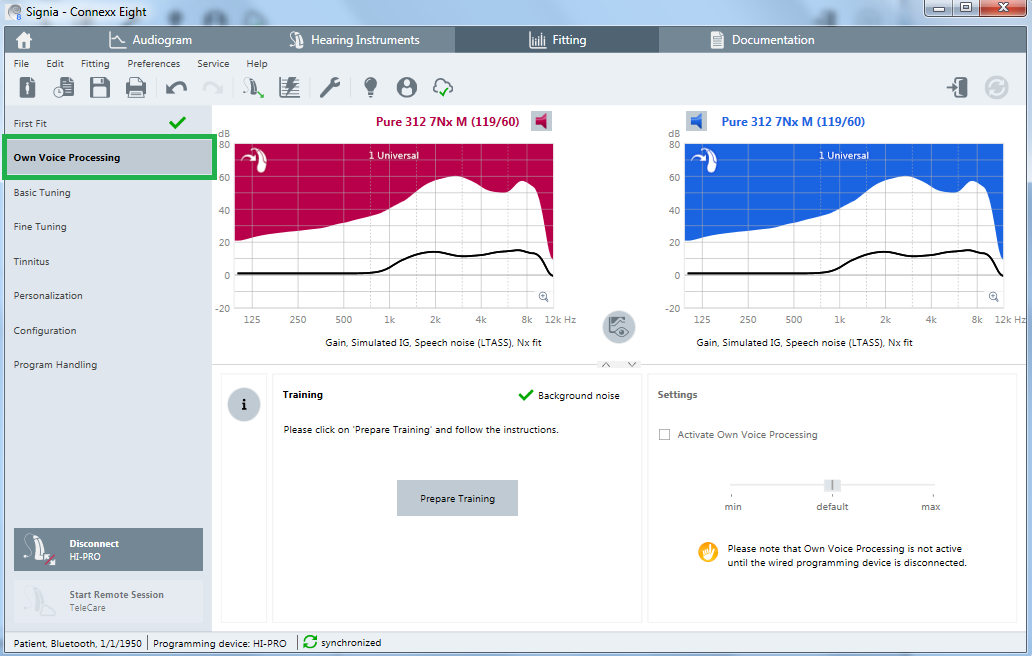
Connexx provides a general indication of whether the background noise level in the room is low enough to carry out the training. When the room is sufficiently quiet, a green check mark appears next to Background noise. If an orange warning is shown instead, it means that the background noise should be reduced before carrying out the training. In this case, it is still possible to perform the training, but the quality of OVP might be less effective.
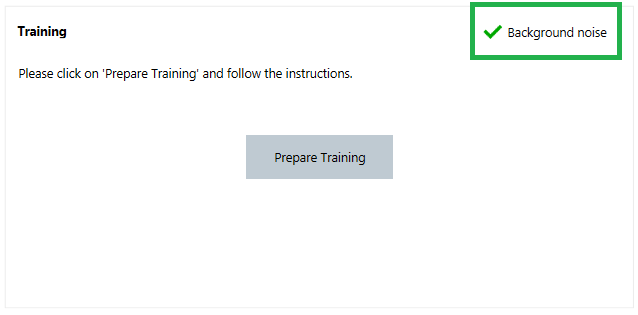
Once the HCP clicks on Prepare Training, Connexx provides helpful guidelines to ensure the best training results. Review these tips before starting the OVP training procedure.
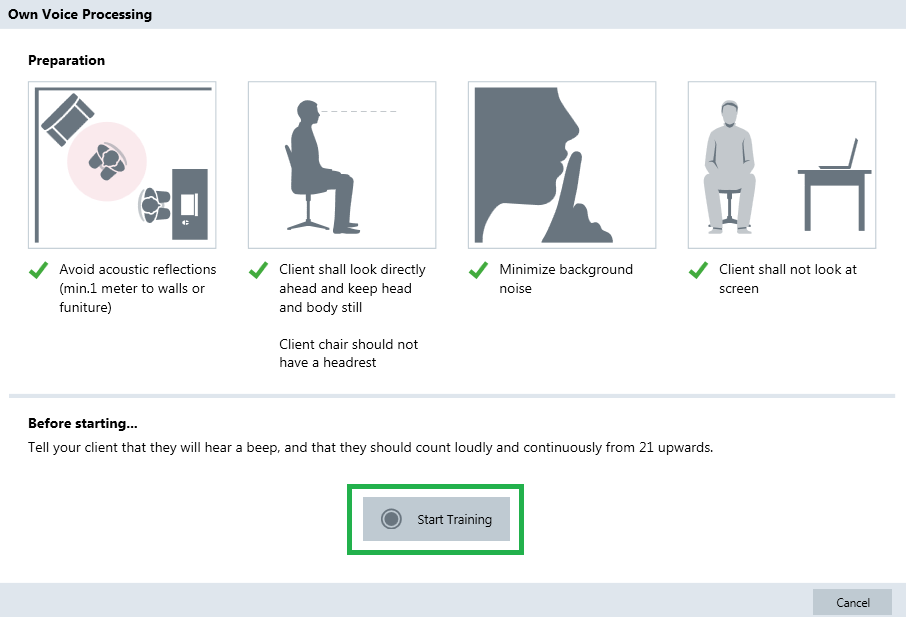
While the patient instructions are to count aloud from 21, exactly what is being spoken aloud is irrelevant. The patient can also count from 1, or count in any language. The key is to talk continuously aloud in a slightly raised volume for the duration of the training.
Once the HCP clicks Start Training, the patient should start counting regardless of the beeps that they may hear in the hearing aids. Note that the patient may also notice that the microphones are muted during training. Count until the green checkmark appears, indicating that training has been completed. This training process usually takes less than 10 seconds.
Click Restart to discard previously recorded training results and repeat the training if necessary. The HCP can also terminate the training if, for example, unexpected noise occurs in the room.

Once training is complete, the Activate Own Voice Processing box is automatically checked and the default setting activated in the Settings panel. The default OVP setting is ideal for the vast majority of wearers and should not be adjusted unless it is specifically necessary.
Besides the music programs, OVP is active in all other hearing aid programs.
If the patient reports that their voice sounds muffled or too soft, consider reducing the setting to min. This may happen for more experienced hearing aid wearers who have become used to hearing their own voice louder. On the other hand, if a new patient still reports that their voice is too loud, consider adjusting the setting to max.
In the event that patient raises own voice issues and adjusting OVP steps does not resolve it, it is likely the result of true occlusion and the HCP should consider increasing the venting accordingly.
Note that if the fitting was carried out using a wired programmer, a message appears here to remind the HCP that the OVP effect will not be audible until the hearing aids are disconnected.
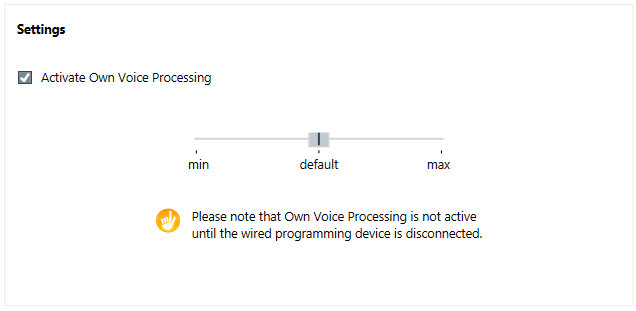
The curve view will now also provide the HCP with a visualization of the OVP gain reduction to indicate that the feature has been activated. This is depicted by the yellow area in the curve view.
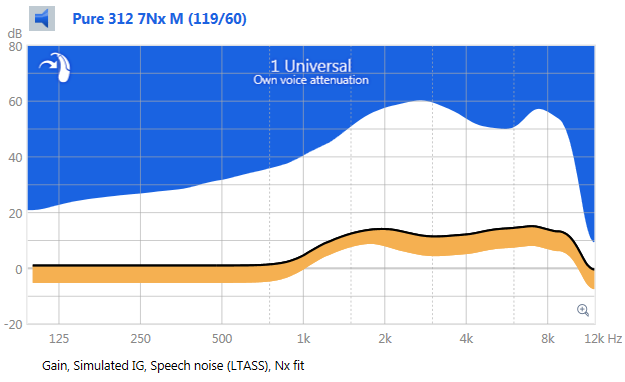
Upon completion of the training and when the wearer’s voice is detected, the hearing aids activate a dedicated own voice processing path, which optimizes the perceived sound quality of the wearer’s voice almost instantly. This is achieved by dynamically adapting gain compression settings to reduce output in relation to the wearer’s voice for the selected acoustic coupling. Conversely, when the wearer’s voice is not detected, the hearing aid immediately reverts to the soundscape processing path.
Since own voice detection is based on spatial cues rather than the “sound quality” of the wearer’s voice, it is highly reliable in real world conditions. If the wearer’s vocal dynamic varies (shouting versus whispering), if the wearer’s voice is affected by a cold, or if the wearer speaks in a different language, the voice detection algorithm retains its accuracy.
With OVP, the adage “fit as open as necessary and as closed as possible” has never been easier to
apply. The positive effect from this improved workflow is that fittings will tend to use less venting and wearers will receive greater benefit from Signia Nx signal processing. Using a more closed fitting path means that the hearing aids can deliver a greater proportion of processed sound versus unprocessed ambient sound, and the wearer receives more benefit from directionality and noise reduction. As such, OVP simplifies the troubleshooting workflow for HCPs even before own voice issues are encountered.
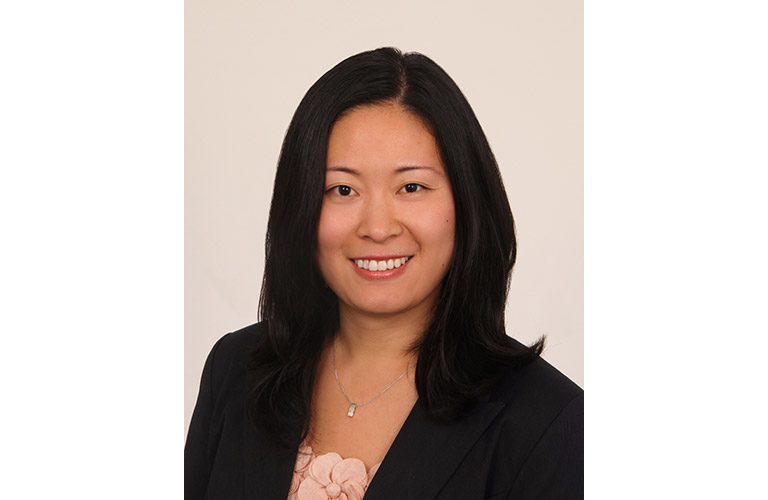
Rebecca Herbig, Au.D., is a Clinical Education Specialist for Sivantos USA. Since 2008, Dr. Herbig has been responsible for various aspects of scientific marketing, both globally and specific to the US market. Prior to joining Sivantos, she worked as a clinical audiologist in northern Virginia. Rebecca received her doctorate in Audiology from Gallaudet University in Washington DC.